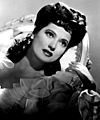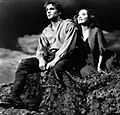Merle Oberon facts for kids
Quick facts for kids
Merle Oberon
|
|
|---|---|

Oberon in 1943
|
|
| Born |
Estelle Merle O'Brien Thompson
19 February 1911 |
| Died | 23 November 1979 (aged 68) Malibu, California, U.S.
|
| Occupation | Actress |
| Years active | 1928–1973 |
| Spouse(s) |
Bruno Pagliai
(m. 1957; div. 1973) |
| Children | 2 |
Merle Oberon (born Estelle Merle O'Brien Thompson; 19 February 1911 – 23 November 1979) was a famous British actress. She started her movie career in Britain. One of her first big roles was as Anne Boleyn in The Private Life of Henry VIII (1933).
After becoming well-known in The Scarlet Pimpernel (1934), she moved to the United States. There, she made movies for producer Samuel Goldwyn. She was even nominated for an Academy Award for Best Actress for her role in The Dark Angel (1935). Merle Oberon kept her mixed family background a secret. She worried it might hurt her acting career.
She is perhaps most famous for playing Catherine Earnshaw in the 1939 movie Wuthering Heights. This film was directed by William Wyler. Other important movies she starred in include These Three (1936), A Song to Remember (1945), Berlin Express (1948), and Désirée (1954). In 1937, she was in a car accident that caused injuries to her face. Many thought her career might be over, but she recovered. She continued acting in movies and on TV until 1973.
Contents
Early Life and Family Secrets
Estelle Merle O'Brien Thompson was born in Bombay, British India, on 19 February 1911. Her family gave her the nickname "Queenie." This was to honor Queen Mary, who visited India with King George V in 1911.
Hiding Her Past
For most of her life, Merle kept her true family story a secret. She often said she was born in Tasmania, Australia. She claimed her birth records were lost in a fire. This helped her avoid unfair treatment because of her mixed background.
Merle was raised by Charlotte Selby, who was Eurasian from Ceylon (now Sri Lanka). Charlotte was presented as Merle's mother. However, Merle's birth certificate showed that her biological mother was Charlotte's 12-year-old daughter, Constance. To avoid a scandal, Charlotte raised Merle as if she were Constance's half-sister.
Later in life, one of Constance's other children, Harry, found Merle's birth certificate. He was surprised to learn that Merle was his half-sister, not his niece. He tried to visit her in Los Angeles, but she refused to see him.
Growing Up in India
In 1914, when Merle was three, her father, Arthur Thompson, joined the British Army. He sadly died from pneumonia during World War I. Merle and Charlotte lived in poor conditions in Bombay for a few years.
In 1917, they moved to Kolkata (then Calcutta) and had a better life. Merle went to La Martiniere Calcutta for Girls, a good private school. But she was often teased because of her mixed background. She eventually left school and was taught at home.
Merle first acted with the Calcutta Amateur Dramatic Society. She loved movies and enjoyed going to nightclubs. An Indian journalist said Merle worked as a telephone operator. She also won a contest at Firpo's Restaurant before starting her movie career.
In 1929, Merle met Colonel Ben Finney, a former actor. He promised to help her meet director Rex Ingram in France. Merle and her mother moved to France. Ingram liked Merle's unique look and hired her as an extra in a movie called The Three Passions.
Becoming a Star
Early Acting Roles
Merle arrived in England for the first time in 1928, when she was 17. She worked as a club hostess and had small, uncredited roles in several movies. She once told a journalist, "I couldn't dance or sing or write or paint. The only possible opening seemed to be in some line in which I could use my face."
Working with Alexander Korda
Her acting career greatly improved when director Alexander Korda noticed her. He gave her an important role as Anne Boleyn in The Private Life of Henry VIII (1933). This movie was a huge success. After that, she got leading roles in other films. These included The Battle (1934) and The Broken Melody (1934).
Merle then made two more movies for Korda. The Private Life of Don Juan (1934) was not very popular. But The Scarlet Pimpernel (1934) was a big hit. She starred with Leslie Howard in that film.
Hollywood Success
Merle's career grew because of her relationship and later marriage to Korda. He helped her get a contract with producer Samuel Goldwyn, and she moved to Hollywood. Her first Hollywood movie was Folies Bergère de Paris (1935).
Goldwyn cast her in The Dark Angel (1935), which earned her an Academy Award for Best Actress nomination. She then starred in These Three (1936) and Beloved Enemy (1936).
In 1937, she was chosen to star in Korda's film I, Claudius. However, a car accident caused injuries that led to the movie being stopped. While in England, she co-starred with Laurence Olivier in The Divorce of Lady X (1938).
Back in Hollywood, Merle Oberon appeared with Gary Cooper in The Cowboy and the Lady (1938). Then she played Cathy in the very popular film Wuthering Heights (1939) with Laurence Olivier.
She made Over the Moon (1939) and The Lion Has Wings (1940) for Korda in England. In 1940, Merle had some skin problems. Alexander Korda sent her to a specialist, and she had treatments. Her face had some marks that needed makeup to hide.
Merle starred in 'Til We Meet Again (1940) and Affectionately Yours (1941). She also appeared in That Uncertain Feeling (1941) and Lydia (1941). She made cameo appearances in Forever and a Day (1943) and Stage Door Canteen (1943).
She played the main female role in The Lodger (1944), a popular mystery film. Dark Waters (1944) was also well-liked. Merle had a big hit with A Song to Remember (1945), where she played George Sand. She also made films like Berlin Express (1948).
Later Acting Years
In France, Merle Oberon appeared in Pardon My French (1951). She then made 24 Hours of a Woman's Life (1952) in England and All Is Possible in Granada (1954). Back in Hollywood, she played Empress Josephine in Désirée (1954). She also had a small role in Deep in My Heart (1954). Her last movie was Interval (1973).
Personal Life
Charlotte Selby, Merle Oberon's birth grandmother, raised Merle as her daughter. This continued until Charlotte's death in 1937. Merle's biological mother was Charlotte's daughter, Constance. Constance was 12 years old when Merle was born.
Marriages and Relationships
Merle Oberon married director Alexander Korda in 1939. She became Lady Korda when her husband was knighted in 1942. They divorced in 1945. She then married cinematographer Lucien Ballard. Ballard created a special camera light for her. This light helped hide her facial scars from the 1937 accident. This light became known as the "Obie." She and Ballard divorced in 1949.
In 1957, Merle married Italian businessman Bruno Pagliai. They adopted two children together. They lived in Cuernavaca, Mexico. In 1973, Merle met Dutch actor Robert Wolders while filming Interval. Merle divorced Pagliai and married Wolders in 1975. He was 25 years younger than her.
Disputed Birthplace
To avoid prejudice about her mixed background, Merle Oberon created a story. She said she was born and raised in Tasmania, Australia. She claimed her birth records were destroyed in a fire. This story became known as untrue after her death.
Merle visited Australia only twice. Her first visit was in 1965 for a movie promotion. Another visit to Hobart was planned. But after journalists asked her about her early life, she became ill and left for Mexico.
In 1978, the year before she died, she agreed to visit Hobart again. The mayor of Hobart learned there was no proof she was born there. But they went ahead with the celebration. At the reception, Merle denied she was born in Tasmania. She then left, saying she was ill. She did not answer more questions about her past.
Death
Merle Oberon stopped acting after Interval. She moved with Robert Wolders to Malibu, California. She died there in 1979 at age 68, after having a stroke. She was buried at Forest Lawn Memorial Park Cemetery in Glendale, California.
Tributes
Merle Oberon has a star on the Hollywood Walk of Fame. It is located at 6274 Hollywood Boulevard in Hollywood, California, USA. This star honors her contributions to movies.
Michael Korda, Alexander Korda's nephew, wrote a book about Merle Oberon after she died. It was called Queenie. This book was later made into a TV miniseries starring Mia Sara.
Filmography
- The Three Passions (1928) as Bit Part (uncredited)
- The W Plan (1930) as Woman at Cafe Table (uncredited)
- Alf's Button (1930) as Bit Part (uncredited)
- A Warm Corner (1930) as Bit Part (uncredited)
- Never Trouble Trouble (1931) as Bit Part (uncredited)
- Fascination (1931) as Flower Seller (uncredited)
- Service for Ladies (1932) as Minor Role (uncredited)
- Ebb Tide (1932) as Girl (uncredited)
- Aren't We All? (1932) as Bit Part (uncredited)
- Wedding Rehearsal (1932) as Miss Hutchinson
- Men of Tomorrow (1932) as Ysobel d'Aunay
- For the Love of Mike (1932) as Bit Part (uncredited)
- Strange Evidence (1933) as Bit Part (uncredited)
- The Private Life of Henry VIII (1933) as Anne Boleyn - The Second Wife
- The Battle (1934) as Marquise Yorisaka
- The Broken Melody (1934) as Germaine Brissard
- The Private Life of Don Juan (1934) as Antonita, a Dancer of Passionate Temperament
- The Scarlet Pimpernel (1934) as Lady Blakeney
- Folies Bergère de Paris (1935) as Baroness Genevieve Cassini
- The Dark Angel (1935) as Kitty Vane (Academy Award nomination for Best Actress)
- These Three (1936) as Karen Wright
- Beloved Enemy (1936) as Lady Helen Drummond
- I, Claudius (1937, unfinished) as Messalina
- The Divorce of Lady X (1938) as Leslie
- The Cowboy and the Lady (1938) as Mary Smith
- Over the Moon (1939) as Jane Benson
- Wuthering Heights (1939) as Cathy
- The Lion Has Wings (1939) as Mrs. Richardson
- 'Til We Meet Again (1940) as Joan Ames
- That Uncertain Feeling (1941) as Jill Baker
- Affectionately Yours (1941) as Sue Mayberry
- Lydia (1941) as Lydia MacMillan
- Forever and a Day (1943) as Marjorie Ismay
- Stage Door Canteen (1943) as Merle Oberon
- First Comes Courage (1943) as Nicole Larsen
- The Lodger (1944) as Kitty Langley
- Dark Waters (1944) as Leslie Calvin
- A Song to Remember (1945) as George Sand
- This Love of Ours (1945) as Karin Touzac
- Night in Paradise (1946) as Delarai
- Temptation (1946) as Ruby
- Night Song (1947) as Cathy
- Berlin Express (1948) as Lucienne
- Pardon My French (1951) as Elizabeth Rockwell
- Dans la vie tout s'arrange (1952, a French version of The Lady from Boston) as Elizabeth Rockwell
- 24 Hours of a Woman's Life (1952) as Linda Venning
- All Is Possible in Granada (1954) as Margaret Faulson
- Désirée (1954) as Empress Josephine
- Deep in My Heart (1954) as Dorothy Donnelly
- The Price of Fear (1956) as Jessica Warren
- Of Love and Desire (1963) as Katherine Beckmann
- The Oscar (1966) as herself
- Hotel (1967) as The Duchess Caroline
- Interval (1973) as Serena Moore (final film role)
Images for kids
See also
 In Spanish: Merle Oberon para niños
In Spanish: Merle Oberon para niños
- English rose (personal description)






